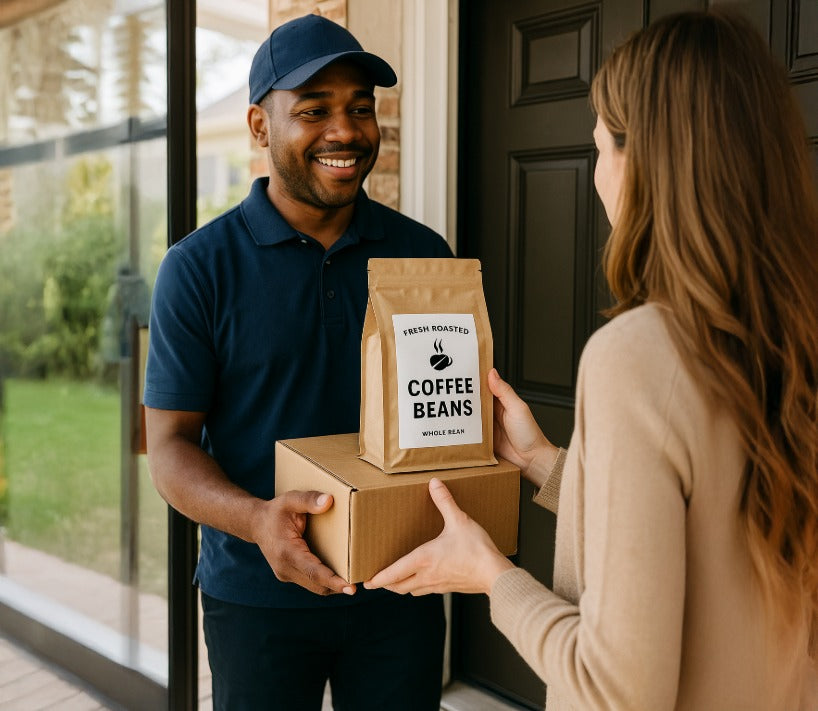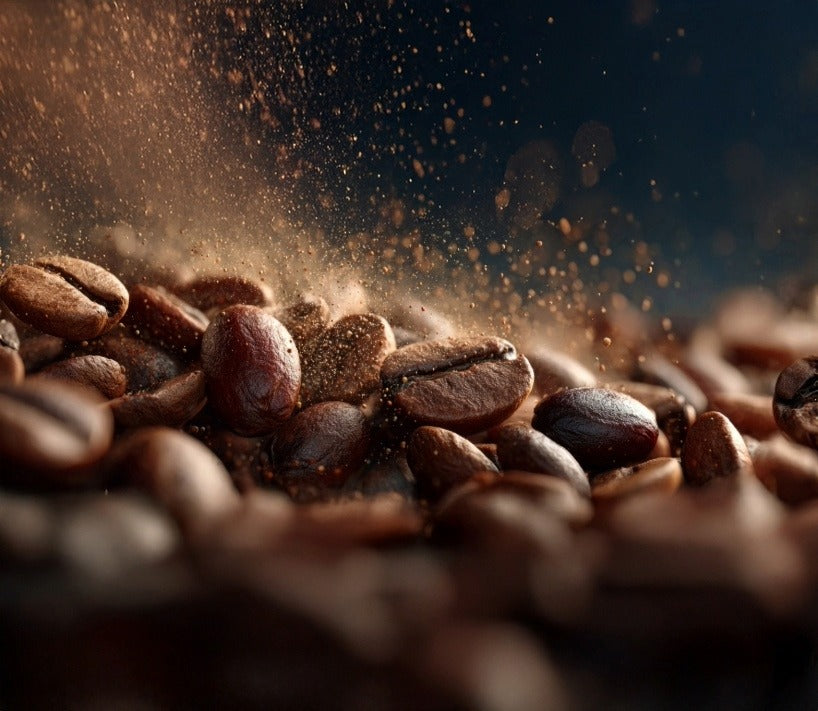Best Guide to Buying Craft Coffee Online
August 12, 2025 6 min read
The No-Guesswork Guide to Buying the Best Craft Coffee Online
 You want cups that make you go “wow,” not “why.” Here’s a complete, step-by-step playbook to shop smarter, skip duds, and land coffee you actually love—every time. We’ll focus on the three levers that matter most:
You want cups that make you go “wow,” not “why.” Here’s a complete, step-by-step playbook to shop smarter, skip duds, and land coffee you actually love—every time. We’ll focus on the three levers that matter most:
- High-scoring, air-roasted specialty coffee
- Freshness you can verify (roast date, not “best by”)
- Roaster style that matches your taste (light, balanced/medium, dark)
Then we’ll decode how processing methods and roast profiles change flavor, aroma, body, and sweetness—so you can aim your taste on purpose.
1) Start with Quality: High-Scoring + Air-Roasted
What “high-scoring” actually means
Specialty coffee is graded on a 100-point scale by trained tasters. 85+ is a strong signal the lot is clean, sweet, and worth your mug. Scores don’t guarantee you’ll love the flavor style, but they raise the floor dramatically (fewer defects, papery cups, or “meh” finishes).
What to look for on the page:
- Mentions of “specialty,” “Q-grade,” 85+
- Transparent sourcing (origin, variety, process, altitude)
- Realistic flavor notes (e.g., strawberry, caramel, cocoa) vs. perfume poetry
Why Air-Roasting Helps?
Traditional drum roasters heat beans in a hot metal drum; air roasters float beans on a bed of hot air. The big advantages:
- Even heat → more consistent development inside each bean
- Cleaner cup → less chaff/smoke clinging to beans
- Flavor clarity → origin character pops (fruit, florals, chocolate)
Translation: air-roasted + high score = less “burnt-toast mystery,” more “oh hey, that is blueberry.”
2) Freshness You Can See: Roast Date > “Best By”
Coffee is a fresh food. A roast date tells you when flavor started its countdown; a “best by” date tells you nothing useful about peak taste.
Prime window (general guide):
- Days 2–14 post-roast: best expression for most brew methods (beans de-gas, flavors open up)
- Days 15–30: still tasty, a touch calmer
- After ~30 days: quality can drop; some coffees hold longer, but don’t bet your morning on it
Rest time by roast:
- Light: 3–7 days to calm “zing” and open sweetness
- Medium: 2–5 days
- Dark: 1–3 days (they de-gas faster)
Storage tips:
- Keep sealed, cool, dry, and dark (pantry, not fridge/freezer)
- Use the bag’s one-way valve; squeeze air out, reseal after each use
- Whole bean > pre-ground for maintaining aroma; grind right before brewing
Red flags: only “best by” dates, no valve, no roast date, or “ships in 3–5 weeks.”
3) Match The Roaster’s Style To Your Taste
Roasters have lanes. Find the lane; find your happy place.
Roast lanes & what they taste like
-
Light Roast (bright & expressive)
Flavor: berries, citrus, florals; sparkly acidity; lighter body
Feels like: lemonade with layers
Best if you like: fruit, tea-like clarity, “new-wave” flavors -
Balanced/Medium (sweet & familiar)
Flavor: milk/dark chocolate, nuts, caramel; rounded acidity; medium body
Feels like: dessert in a mug
Best if you like: cozy, every-day sweet cups -
Dark (bold & toasty)
Flavor: roasty notes, smoke, baking chocolate; low acidity; heavy body
Feels like: winter coat for your tongue
Best if you like: big, robust “coffee-coffee”
Fast lane-picker:
- Say “chocolatey” → choose medium
- Say “fruity” → choose light
- Say “smoky/strong” → choose dark
How Processing Shapes Flavor & Aroma
Processing is how the fruit is removed and the seed (your coffee bean) is dried. It changes sweetness, aroma, clarity, and mouthfeel—before roasting ever begins.
-
Washed (a.k.a. wet process)
Fruit is removed before drying.
Taste: clean, bright, clear fruit and florals; higher clarity, lighter body
Pick this if: you like crisp, tidy flavors (think apple, citrus, black tea) -
Natural (a.k.a. dry process)
Bean dries inside the whole fruit, raisin-style.
Taste: fruit-forward and jammy; more sweetness; heavier aromatics
Pick this if: you want blueberry, strawberry, tropical fruit vibes -
Honey (in-between)
Some sticky fruit mucilage stays on during drying.
Taste: round, honeyed sweetness; less tang than washed; good balance
Pick this if: you want sweet without high zing; caramel, stone fruit -
Anaerobic / Fermented
Beans rest in sealed tanks with controlled oxygen; sometimes “carbonic maceration.”
Taste: big aromatics; tropical, spiced, sometimes funky/tangy
Pick this if: you like adventure and wine-like complexity (start with a small bag) -
Wet-hulled (common in Indonesia)
Parchment removed early; dried differently due to climate.
Taste: earthy, herbal, deep; syrupy body
Pick this if: you enjoy forest-after-rain, cocoa, tobacco leaf tones
Quick map: Clean & crisp → Washed. Sweet & jammy → Natural. Sweet & smooth → Honey. Tropical & wild → Anaerobic. Deep & earthy → Wet-hulled.
How Roast Level Changes What You Taste (the nerdy but useful part)
-
Aroma & flavor:
Lighter roasts preserve delicate origin aromatics (floral, berry).
Medium emphasizes Maillard sweetness (caramels, nuts, chocolates).
Dark pushes caramelization/pyrolysis (roasty, smoky, bitter-sweet cocoa). -
Acidity (the pleasant kind):
Light > Medium > Dark (generally). Lighter roasts keep more lively acidity; darker roasts mute it. -
Body & mouthfeel:
Darker roasts feel heavier/syrupier; light roasts feel lighter/juicier. -
Solubility (how easily flavors extract):
Dark > Medium > Light. Dark roasts extract faster; light roasts need finer grind and better technique to sing.
If your cup tastes…
- Sour/sharp: grind finer, brew hotter/longer, or slide toward medium roast and/or washed process.
- Bitter/ashy: grind coarser, brew cooler/shorter, or slide toward lighter roast.
- Flat/dull: try natural or honey processes or one notch lighter roast for more sparkle.
Brew Method Pairings (so the coffee & gear get along)
- Drip machine / Pour-over: light or medium to showcase clarity and sweetness (washed, honey, or clean naturals).
- French press: medium or dark for body and a chocolate-forward profile (honey, washed, wet-hulled).
- Espresso: medium-dark for classic chocolate/nut shots; light–medium naturals for modern fruit-forward shots (dial-in required).
- Iced coffee/flash brew: light–medium washed or honey to keep flavors bright and sweet over ice.
Read any product page in 30 seconds (the “no regret” audit)
- Quality: says specialty / 85+ and ideally air-roasted.
- Freshness: roast date printed (not best by), frequent roast schedule, quick ship.
- Style: a clear roast level (light/medium/dark).
- Process: washed/natural/honey/anaerobic/wet-hulled is stated (not hidden).
- Tasting notes: believable and specific (cocoa, almond, cherry), not fantasy novels.
- Transparency: origin, altitude, variety when possible.
- Contact: the roaster invites questions (chat, email, DM). Conversation wins.
Hard pass signs: generic “gourmet,” no roast date, only best-by, fuzzy sourcing, every bag has the same tasting notes, or “roasted on demand” but ships weeks later.
Use this message to get a perfect recommendation
“Hey! I like [fruity / chocolatey / smoky] flavors. I brew [pour-over / drip / French press / espresso]. I prefer [light / medium / dark] roasts. Do you have something [washed / natural / honey / etc.] with a fresh roast date this week? Bonus if it has [note you love: strawberry / caramel / dark chocolate].”
A good roaster will reply like a friendly guide and point you to a bullseye bag. If they don’t, that’s your sign.
Whole bean vs pre-ground (and how to ask for help)
- Whole bean preserves aroma the longest. Grind right before brewing.
- No grinder? Ask for a brew-specific grind: “# for drip,” “coarse for French press,” “fine for espresso.” Fresh roast + correct grind still tastes great.
Flavor translator (what you like → what to buy)
|
If you love… |
Try this roast |
Try this process |
Likely notes |
|
Bright fruit & tea |
Light |
Washed |
citrus, florals, stone fruit |
|
Blueberry jam vibes |
Light–Medium |
Natural |
blueberry, strawberry, candy |
|
Dessert-y comfort |
Medium |
Honey |
caramel, nougat, red apple |
|
Deep & earthy |
Medium–Dark |
Wet-hulled |
cocoa, cedar, spice |
|
Classic “coffee” |
Medium–Dark |
Washed/Honey |
chocolate, toasted nuts |
|
Tropical & wild |
Light–Medium |
Anaerobic |
pineapple, spice, cola |
The 60-second checkout checklist
High-scoring? (85+) → yes
Air-roasted? → yes
Roast date? → printed and recent
Roast lane? → matches your taste (light/medium/dark)
Process? → fits your flavor goals (washed/natural/honey/… )
Brew match? → pairs well with your method
Shipping? → fast enough to drink inside the prime window
Questions? → send the message above and get a human answer
Do that, and you’ll stop gambling on bags and start collecting favorites.
Final nudge (your quick win today)
Pick one:
- If you want clean & bright: get a light, washed coffee with a clear roast date.
- If you want sweet & comfy: get a medium, honey coffee roasted this week.
- If you want bold & classic: get a medium-dark, washed coffee roasted in the last few days.
Then tell the roaster what you liked about it. Good roasters remember and guide you even closer next time. That’s how you turn “best craft coffee at home” from a wish into your new normal.
PS - You can always give my fresh, high-scoring air-roasted coffee a try with 14-days of FREE coffee. You'll only pay for 3, but add 4 bags to your cart, and enter code: BetterMornings
Also in Best Coffee To Buy Online Education

Best Fresh Roasted Coffee Delivery Online
November 28, 2025 4 min read
I roast the best tasting coffee at home for you! I use 100% electric equipment, so no hydrocarbons here. Best fresh roasted coffee delivery starts with high-scoring specialty coffee online.

Which Roaster Makes Better Coffee: Gas or Electric?
November 27, 2025 4 min read
Why electric drum roasters produce cleaner, sweeter, more consistent coffee—especially the kind you want when buying fresh roasted coffee beans online or trying to make the best tasting craft coffee at home.

Biggest Coffee Buying Mistake at Home
November 26, 2025 4 min read
Learn why the roast date matters and how to buy fresh, high-quality specialty coffee online. No guesswork when you order coffee online with me. I only stock, roast, and process the best tasting craft coffee at home. I am YOUR personal roaster.
